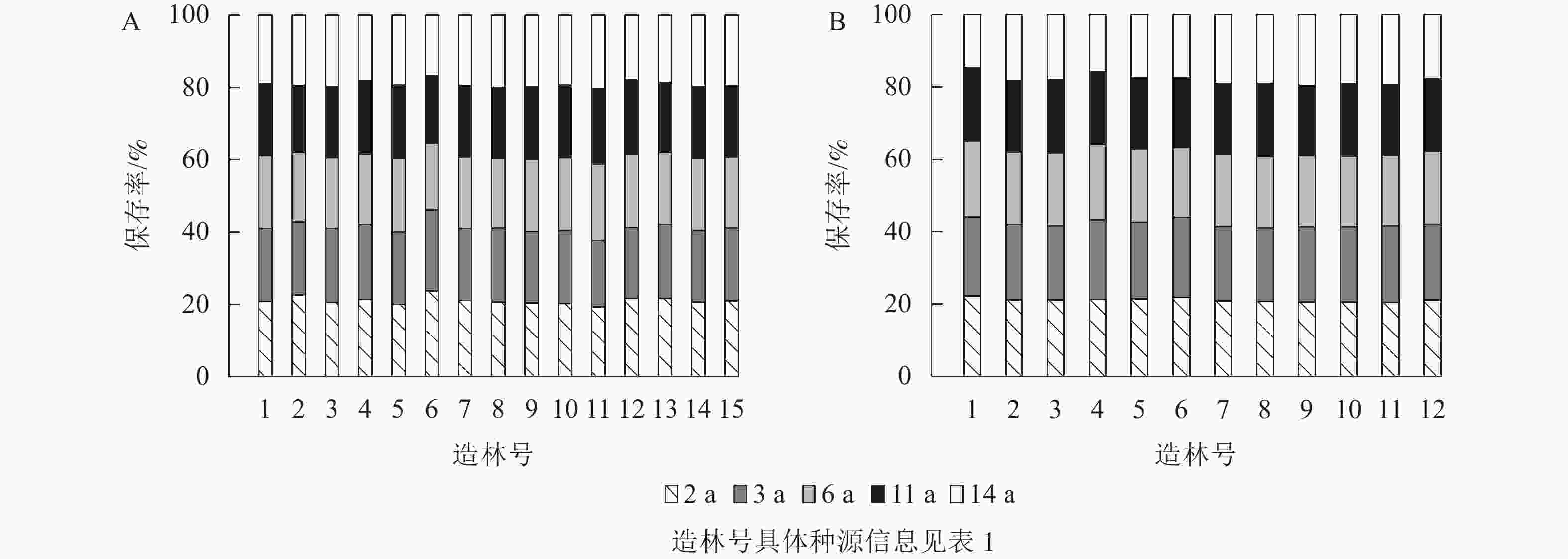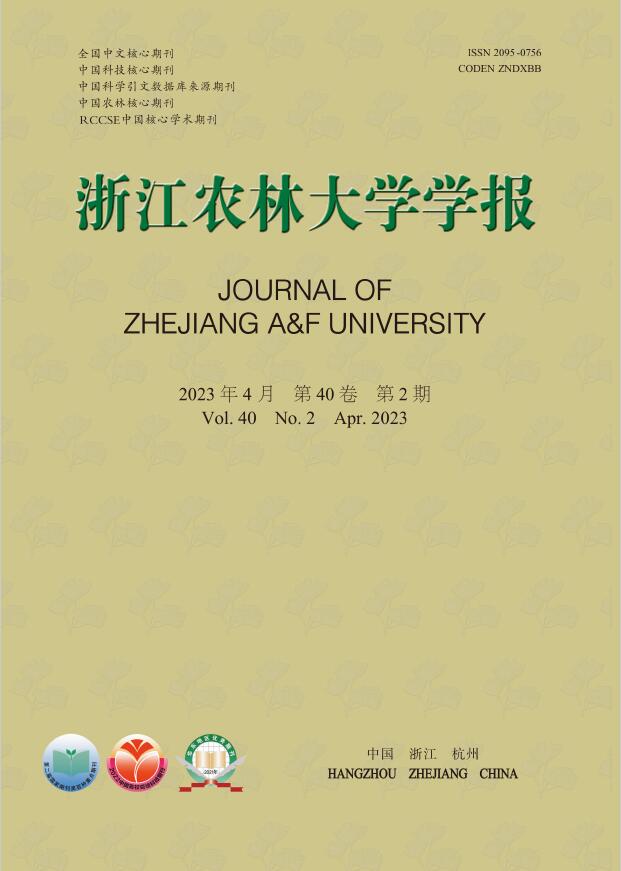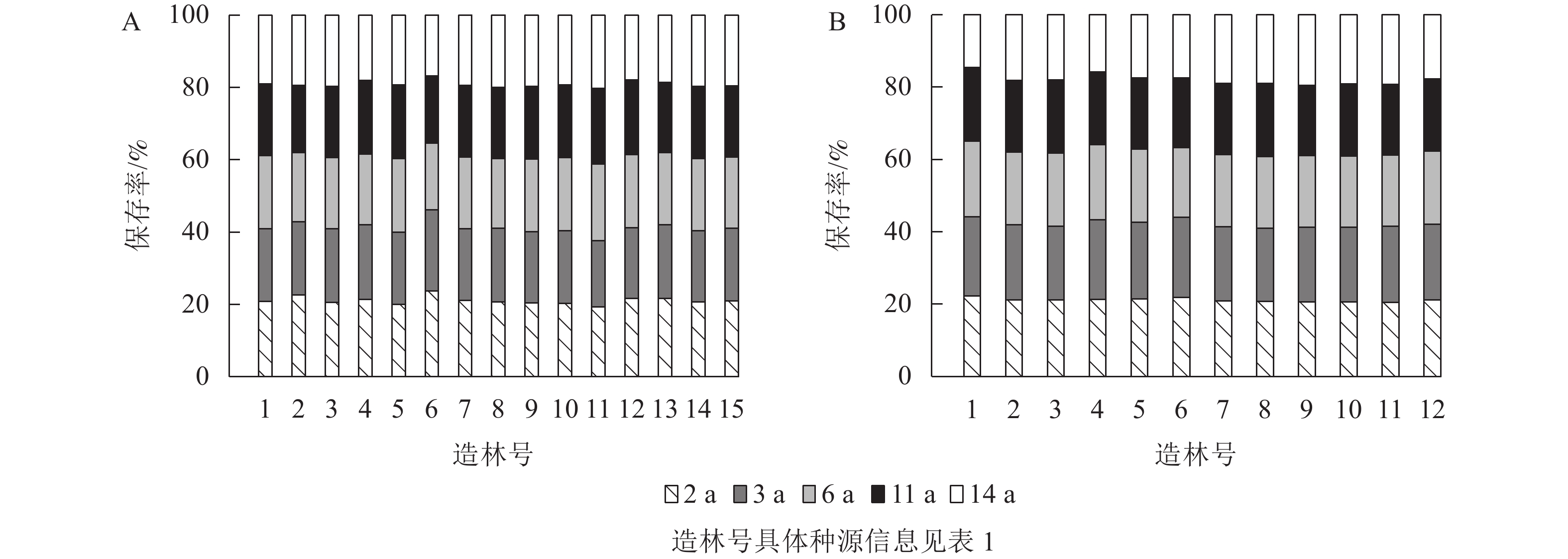-
乐昌含笑Michelia chapensis为木兰科Magnoliaceae含笑属Michelia常绿大乔木,已被列入中国《国家二级保护植物名录》,具有生长快、树干挺拔、花色优雅、四季葱郁、木材易于加工等优良特性,是中国南方优良的乡土阔叶树种[1−2]。自20世纪80年代起,乐昌含笑树种逐渐得到重视,早期多应用于园林绿化中,近些年在森林康养、生态公益林、碳汇林建设中得到广泛应用[2−4]。种源选择是树种改良的重要方法之一,在林业生产中具有重要作用。但由于林木的生长周期长,且不同生长期所表达的基因不同,给林木育种策略的科学制定带来困难[5]。根据目标性状的遗传力和幼林期与成熟林期性状相关性随年龄增长的变化趋势,可确定种源的早期选择年龄,进而加速林木遗传改良的进程[5−9]。但乐昌含笑树种研究起步较晚,较多研究集中在种群分布、苗木繁育、栽培技术等方面,在遗传改良方面的研究,尤其是早期选择适宜林龄的研究较少[10]。广东省于2003年启动乐昌含笑良种选育研究工作,并先后在广东省内多个区域布置了种源和家系试验林[11]。目前,早期营建的试验林已达近熟林期,了解此期间林木主要生长性状的变异特征,以及生长性状的早晚期相关性,对推进乐昌含笑遗传改良进程具有重要意义。本研究根据早期营建的乐昌含笑种源试验林的多年度观测数据,分析乐昌含笑生长性状的年度变化模式及性状间的早晚期相关性,为解析乐昌含笑种源的生长变异规律以及开展早期选择提供理论依据。
-
以广东省韶关市国有曲江林场和国有九曲水林场为研究地。其中,曲江林场试验林(QJ06)地处24°41′N,113°36′E,年均气温为20.5 ℃,年均积温为6 559.5 ℃,年均降水量为1 751 mm,位于山坡下部,海拔约180 m。九曲水林场试验林(JQS06)地处24°22′N,114°05′E,年均气温为20.3 ℃,年均积温为6 570.7 ℃,年均降水量为1 787 mm,位于山坡下部,海拔约250 m。2片试验林均为花岗岩成土,红壤,土层厚1 m以上,肥力中等。
-
曲江林场试验林参试种源15个,九曲水林场试验林参试种源12个(表1)。2004年采集种子,2005年培育苗木,所有造林苗木均为1年生容器苗,出圃规格为苗高≥35 cm,地径≥0.5 cm。
造林号 种源号 来源地 经纬度 试验林 曲江林场 九曲水林场 1 HNLL 湖南醴陵县王仙镇 27.663°N,113.455°E 有 有 2 HNTD 湖南通道县草坪镇 26.216°N,109.732°E 有 有 3 HNZX 湖南资兴县黄草镇 25.934°N,113.452°E 有 有 4 HNGD 湖南桂东县红星镇 25.982°N,113.893°E 有 有 5 HNSN 湖南遂宁县黄桑镇 26.713°N,110.196°E 有 有 6 JXCY 江西崇义县茶滩镇 25.677°N,113.452°E 有 有 7 JXSY 江西上犹县陡水镇 25.935°N,114.392°E 有 有 8 JXLN 江西龙南县九连山 24.856°N,114.512°E 有 有 9 LCJF 广东乐昌县九峰镇 25.243°N,113.244°E 有 有 10 MZF 广东南雄县帽子峰镇 25.184°N,114.366°E 有 有 11 NXJT 广东南雄县江头镇 25.183°N,114.376°E 有 有 12 RHCJ 广东仁化县长江镇 25.203°N,113.767°E 有 有 13 SXLJ 广东始兴县刘家山 24.847°N,114.099°E 有 无 14 JXQN 江西全南县龙下镇 24.854°N,114.517°E 有 无 15 JXAY 江西安远县车头镇 25.233°N,115.384°E 有 无 Table 1. Information of tested provenance
-
试验林采用随机完全区组设计,18株小区(3株×6株或2株×9株),4次重复。2005年底完成试验林整地,植穴规格为50 cm×40 cm×35 cm,每穴施250 g磷肥为基肥。试验林四周栽植2行木荷Schima superba作隔离行。2006年3月造林,造林当年及第2年每年抚育2次,第3年抚育1次,均未追肥。2007年11月调查试验林2年生的保存率,2008年11月、2011年11月、2016年11月、2019年11月分别对试验林进行每木调查,其中树高用塔尺测量,胸径用胸径尺测量,测量位置为树干根部往上1.3 m处。
-
利用SAS 9.1统计软件[12]对数据进行分析。在Proc Means过程中进行数据特征描述,应用限制最大似然(REML)方法在Proc Mixed 过程估算各效应方差分量,应用SIN方法在Proc Cluster过程进行聚类分析,以小区平均值为数据运用Proc GLM过程进行单地点方差分析,分析模型为:Yij=μ+Bi+Fj+Eij。其中:Yij为i区组j种源的小区平均值,μ为性状的群体均值,Bi为i区组效应,Fj为第j个种源效应,Eij为j种源i区组的小区均值离差。单株材积、表型相关系数、遗传相关系数、种源遗传力等估算公式参照文献[11]。
-
从图1可见:2片乐昌含笑试验林的保存率均较高,其中,在林龄2 a时,保存率曲江林场试验林为85.19%,九曲水试验林为95.02%。曲江林场和九曲水试验林的保存率变化趋势较相似,在林龄3~11 a间保存率均变化不大,分别为80.56%~81.51%和89.24%~94.44%;在林龄11~14 a间保存率有较明显下降,在林龄14 a时,曲江林场试验林为77.96%,九曲水林场试验林为80.79%。

Figure 1. Preservation rate of different ages of two testing forests in Qujiang forest farm (A) and Jiuqushui forest farm (B)
由乐昌含笑种源不同林龄生长表现(表2)可知:曲江林场试验林树高速生期出现在林龄3 a之前和11~14 a,年均生长量分别为0.79和0.81 m·a−1;胸径速生期出现在林龄3~6 a和11~14 a,年均生长量分别为1.20和1.05 cm·a−1。九曲水林场试验林树高的速生期出现在林龄3 a之前和6~11 a,年均生长量分别为0.98和0.63 m·a−1;胸径速生期出现在林龄3~6 a和6~11 a,年均生长量分别为0.95和0.80 cm·a−1。2片试验林单株材积生长速生期均在林龄11~14 a。随着林龄的增大,3个生长性状在种源间的分化也不断增大,各性状的变异系数随林龄的增长呈逐渐增大后减小的趋势,从大到小依次为单株材积变异系数、胸径变异系数、树高变异系数。
试验林 林龄/a 树高 胸径 单株材积 均值/m 变幅/m 变异系数 均值/cm 变幅/cm 变异系数 均值/m3 变幅/m3 变异系数 曲江林场 3 2.36 1.20~4.40 12.37 1.68 0.20~5.50 22.53 3.93×10−4 2.17×10−6~4.37×10−3 48.98 6 4.04 1.40~7.60 17.19 5.28 0.50~14.90 24.32 6.38×10−3 1.00×10−5~5.85×10−2 58.77 11 7.31 2.20~13.50 15.59 9.48 2.00~25.00 18.95 3.47×10−2 5.20×10−4~2.78×10−1 52.87 14 9.73 2.40~17.50 11.58 12.64 2.50~30.50 15.37 8.10×10−2 6.10×10−4~4.54×10−1 36.49 九曲水林场 3 2.94 1.00~6.20 9.72 2.88 0.50~8.40 17.34 1.24×10−3 1.00×10−5~1.22×10−2 38.08 6 4.76 1.50~11.00 10.24 5.73 0.70~16.50 13.72 8.39×10−3 2.00×10−5~1.08×10−1 41.27 11 7.93 2.50~18.10 10.65 9.74 2.20~23.50 13.92 3.54×10−2 6.10×10−4~3.22×10−1 42.91 14 9.37 2.80~16.20 11.64 11.09 2.40~34.20 13.78 6.27×10−2 8.50×10−4~6.76×10−1 34.90 Table 2. Growth performance of provenances at different ages
-
方差分析结果(表3)显示:不同林龄的树高、胸径、单株材积在参试种源间均达到极显著水平(P<0.01),说明不同种源的生长性状存在很大差别,从种源试验林中筛选丰产型优良种源以及开展种源早期选择是可行的。由方差分量占比分析结果还可知:在不同林龄时,遗传效应、环境效应以及遗传和环境互作效应都对乐昌含笑生长性状的变异有影响。在遗传方面,树高、胸径和单株材积生长性状的遗传模式比较一致,总体表现为随林龄增大遗传效应逐渐增强或趋于平稳的趋势;不同林龄遗传效应的影响总体大于遗传和环境互作效应的影响,这种差异在林龄为14 a时尤其明显。此外,环境效应对生长性状的影响也不容忽视,其中,曲江林场试验林中环境效应表现为随林龄增加影响逐渐减少的趋势,在九曲水林场试验林中不同林龄的环境效应则表现相对稳定,这也说明了在种源试验过程中控制环境变异并提高测量准确性是十分必要的。
性状 林龄/a 曲江林场试验林 九曲水林场试验林 自由度 F 方差分量占比/% 自由度 F 方差分量占比/% 种源 种源×区组 误差 种源 种源×区组 误差 树高 3 14 3.64** 30.02 27.80 42.18 11 5.58** 40.89 23.41 35.70 6 14 4.40** 31.31 31.81 36.88 11 8.25** 53.51 16.98 29.51 11 14 5.68** 37.78 29.93 32.29 11 7.12** 43.90 25.50 30.60 14 14 9.94** 56.29 18.53 25.18 11 6.74** 41.25 21.35 37.40 胸径 3 14 4.52** 36.28 22.46 41.26 11 3.19** 24.45 30.86 44.69 6 14 4.54** 32.88 29.97 37.15 11 7.97** 53.32 16.09 30.59 11 14 6.52** 42.62 26.50 30.88 11 7.12** 46.22 23.58 30.20 14 14 9.11** 57.16 14.64 28.20 11 7.37** 55.43 9.76 34.81 单株材积 3 14 5.41** 44.65 14.85 40.50 11 3.79** 30.47 25.80 43.73 6 14 3.55** 33.32 25.97 40.71 11 4.71** 36.64 23.89 39.47 11 14 4.24** 32.42 30.23 37.35 11 4.52** 32.38 30.79 36.83 14 14 6.93** 48.02 19.61 32.37 11 6.30** 51.19 10.21 38.60 说明:**表示性状方差分析差异极显著(P<0.01) Table 3. Variance analysis of growth traits at different ages
-
由表4表明:树高、胸径、单株材积3个性状的种源遗传力均属中上水平,变幅为0.69~0.90。其中,曲江林场试验林树高、胸径的种源遗传力随林龄增加呈逐渐增大后趋于稳定的趋势,到林龄14 a时分别为0.90和0.89;而九曲水林场试验林不同林龄各性状的种源遗传力表现相对稳定,为0.82~0.88。
林龄/a QJ06遗传力估算值 JQS06遗传力估算值 树高 胸径 单株材积 树高 胸径 单株材积 3 0.73 0.78 0.82 0.82 0.69 0.74 6 0.77 0.78 0.72 0.88 0.88 0.79 11 0.82 0.85 0.76 0.85 0.86 0.78 14 0.90 0.89 0.86 0.82 0.86 0.84 说明:QJ06为曲江林场试验林;JQS06为九曲水林场试验林 Table 4. Estimation of provenance heritability of growth traits at different ages
-
利用不同林龄参试种源的树高、胸径、单株材积分别与14 a的单株材积做相关分析可知(表5):2片试验林不同林龄各性状间的表型相关系数为0.22~0.44,遗传相关系数为0.83~1.00。遗传相关系数均大于表型相关系数,并在林龄为3 a以上时,呈极显著正相关关系(P<0.01)。表明乐昌含笑单株材积的早期选择在林龄为3 a后开展是可行的。随着林龄的增大,曲江林场试验林各性状间的表型和遗传相关系数均相对稳定,而九曲水林场试验林各性状间的表型和遗传相关系数则有逐渐增大后趋于稳定的趋势,而且不同林龄的胸径与14 a的单株材积间的相关系数均大于树高与其的相关系数,到林龄6 a时,其胸径、单株材积和14 a的单株材积间的遗传相关系数均达到1.0并趋于稳定。由此推测,根据幼林期胸径或单株材积的生长选择乐昌含笑丰产型优良种源,其效果应优于根据树高的选择效果,而且选择林龄越晚,选择效果将会越好。
性状 林龄/a QJ06试验林14 a
单株材积JQS06试验林14 a
单株材积表型相
关系数遗传相
关系数表型相
关系数遗传相
关系数树高 3 0.42** 0.98** 0.29** 0.83** 6 0.35** 0.95** 0.29** 0.92** 11 0.41** 0.96** 0.38** 0.95** 胸径 3 0.38** 0.97** 0.30** 0.98** 6 0.36** 0.97** 0.31** 1.00** 11 0.40** 0.98** 0.41** 1.00** 单株材积 3 0.37** 1.00** 0.22** 0.90** 6 0.36** 0.97** 0.35** 1.00** 11 0.37** 0.96** 0.44** 1.00** 说明:QJ06为曲江林场试验林;JQS06为九曲水林场试验林。**表示两两性状间极显著相关(P<0.01) Table 5. Correlation coefficients of the main growth traits between the juvenile and mature age
-
种源分类评价方法有综合指标法和单指标法。综合指标法利用胸径、树高、单株材积3个指标的聚类分析结果进行种源分类评价;单指标法依据单株材积1个指标的大小进行种源分类评价。根据聚类分析结果,可把种源分为3类(表6)。其中:综合指标法的分类标准为:Ⅰ类种源总体生长表现最好,其树高、胸径、单株材积3个指标与群体均值相比均有明显增益,为丰产型种源;Ⅱ类种源总体生长表现较好,树高、胸径、单株材积3个指标与群体均值相比差异不明显,为普通型种源;Ⅲ类种源总体生长表现较差,树高、胸径及单株材积均明显小于群体均值,为低产型种源。单指标法的分类标准为:Ⅰ类丰产型种源,单株材积生长表现最好,与群体均值相比现实增益≥15%;Ⅱ类普通型种源,单株材积生长表现较好,与群体均值相比现实增益为0~15%;Ⅲ类低产型种源,单株材积生长表现较差,与群体均值相比无增益。在不同林龄时,曲江林场试验林采用2种评价方法筛选所得丰产型Ⅰ类种源的数量占比均为33%~40%,九曲水林场试验林采用综合指标法筛选所得Ⅰ类种源的数量占比为17%~42%,单指标法所得Ⅰ类种源的数量占比为25%~33%,而且2种评价方法各类群所归类的种源个体总体差异不明显,表明2种方法对Ⅰ类种源的分类结果较一致,但单指标法在操作上相对来说更简单。此外,表6还表明:2片试验林中绝大多数种源的早晚期生长表现较一致,如造林号为8、10、11、14、15的种源在各林龄时均属于Ⅰ类种源,具有良好的持续生长特性;而在林龄3、6 a时属于Ⅲ类的种源,绝大部分在林龄11、14 a时仍属于Ⅲ类。这说明乐昌含笑生长性状具有较好的稳定性。
试验林 类群 林龄3 a的种源 林龄6 a的种源 林龄11 a的种源 林龄14 a的种源 综合指标 单指标 综合指标 单指标 综合指标 单指标 综合指标 单指标 曲江林场 Ⅰ 7、8、10、11、14、15 7、8、10、11、14、15 8、10、11、14、15 8、10、11、14、15 8、10、11、14、15 7、8、10、11、14、15 8、10、11、14、15 8、10、11、14、15 Ⅱ 9、13 9、13 7、9 7、9 7、9 9 7、9、13 7、9、13 Ⅲ 1、2、3、4、5、6、12 1、2、3、4、5、6、12 1、2、3、4、5、6、12、13 1、2、3、4、5、6、12、13 1、2、3、4、5、6、12、13 1、2、3、4、5、6、12、13 1、2、3、4、5、6、12 1、2、3、4、5、6、12 九曲水林场 Ⅰ 7、8、10、11 7、8、10、11 7、8、10、11 7、8、10、11 7、8、10、11 7、8、10、11 8、10、11 7、8、10、11 Ⅱ 2、6、9、12、 2、4、9、12 2、4、9、12 4、9 4、7、9 4、9 Ⅲ 1、3、4、5 1、2、3、4、5、6、9、12 1、3、5、6 1、2、3、4、5、6、9、12 1、3、5、6 1、2、3、5、6、12 1、2、3、5、6、12 1、2、3、5、6、12 说明:表中数字为参试种源对应的造林号,具体种源信息见表1 Table 6. Clustering analysis of provenances at different ages
-
作为一般用材林经营时,软阔类树种龄级划分标准为:林龄≤5 a为幼龄林,6~10 a为中龄林,11~15 a为近熟林,16~25 a为成熟林[13]。据此可知,本研究乐昌含笑种源试验林已是近熟林。若分别以综合指标和单指标法进行种源分类评价,以林龄14 a的近熟林Ⅰ类种源选择结果为标准,进一步对不同林龄筛选出的Ⅰ类种源进行风险评估(表7)。由表7可知:采用2种分类评价方法开展Ⅰ类种源选择,在林龄3、6 a时,曲江林场试验林Ⅰ类种源的选对率分别为83%、100%,漏选率均为0;九曲水林场试验林则以单指标法选对率更高,在林龄3、6 a的选对率均为100%,而综合指标法的选对率均为75%,2种方法的漏选率均为0。由此可知,2种分类评价方法的早期选择风险存在一定差异,总体上以单指标法开展早期选择的风险更低,但采用2种分类评价方法在林龄为3、6 a时开展Ⅰ类种源的早期选择,所得Ⅰ类种源中均能包含14 a时入选Ⅰ类种源的100%。
评价
方法林龄/
a曲江林场试验林 九曲水林场试验林 入选数/
个选对数/
个选对率/
%错选数/
个错选率/
%漏选数/
个漏选率/
%入选数/
个选对数/
个选对率/
%错选数/
个错选率/
%漏选数/
个漏选率/
%单指标 3 6 5 83 1 17 0 0 4 4 100 0 0 0 0 6 5 5 100 0 0 0 0 4 4 100 0 0 0 0 11 6 5 83 1 17 0 0 4 4 100 0 0 0 0 14 5 5 100 0 0 0 0 4 4 100 0 0 0 0 综合指标 3 6 5 83 1 17 0 0 4 3 75 1 15 0 0 6 5 5 100 0 0 0 0 4 3 75 1 15 0 0 11 5 5 100 0 0 0 0 4 3 75 1 15 0 0 14 5 5 100 0 0 0 0 3 3 100 0 0 0 0 Table 7. Selection risk of M. chapensis provenances at different ages
-
本研究的2片乐昌含笑种源试验林林木保存率随着林龄的增大以及个体间竞争的加大而逐渐降低,尤以林龄11~14 a的保存率下降速度较快。据观察,死亡的个体多为林冠内中、下层林木,这些矮小林木的死亡,会对参试种源生长量评价及遗传参数估算产生不利影响。因此,在现有3 m×3 m的造林密度下,在已郁闭且林木尚未大量死亡前作评价,结果是相对可靠的;当死亡植株大量增加时,评价结果将产生较大偏差。若要比较准确评价参试种源在达到轮伐期时的现实生产力,则在造林时适当加大株行距以增大种植空间可能更合适。
性状的遗传变异是林木遗传改良的前提,丰富而有效的遗传变异奠定了林木的改良潜力[5, 14]。丘作忠等[15]对九曲水林场试验林的研究表明:林龄为6 a时,树高、胸径、单株材积生长性状和树干通直度、冠幅、树冠密度等性状在种源间均有极显著差异,生长性状的种源遗传力为0.79~0.88,若以单株材积为选择目标时,可筛选出优良种源4个,材积现实增益达27.78%~84.43%。王润辉等[11]进一步对在2006年春季造林的九曲水林场试验林、曲江林场试验林、八一林场试验林(已在2015年被砍伐) 3片乐昌含笑种源试验林林龄为6 a的调查表明:种源、地点及种源和地点互作效应均对树高、胸径、单株材积有显著或极显著影响,3个生长性状的种源遗传力为0.70~0.80,结合多地点种源年生长量指标综合表现,可筛选出优良种源6个,材积现实增益达11.95%~41.03%。本研究表明:在林龄为3~14 a,乐昌含笑胸径、树高、单株材积在参试种源间均存在极显著差异,表明生长性状在种源间存在丰富变异,这与之前的研究结果相似[11, 15]。性状的遗传力是从亲代传递给子代的能力上得以体现,本研究中,乐昌含笑种源不同林龄的树高、胸径、单株材积的种源遗传力为0.69~0.90,均在中等以上水平。而且随着林龄的增加,各性状的遗传力表现为上升并趋于稳定的趋势,说明乐昌含笑种源生长性状有较为稳定的遗传特性,也进一步表明乐昌含笑种源早期选择的可行性。
早期选择是缩短林木育种周期、提高遗传改良效率的重要手段,对林业生产和林木育种工作具有重要意义[16−17]。林木生长性状的早晚相关性为早期选择提供了理论基础[18],但不同树种由于不同的生长规律、木材用途及培育目标,其早期选择年龄存在较大的差异。相关研究多集中在杉木Cunninghamia lanceolata、马尾松Pinus massoniana等传统针叶用材树种上。如叶培忠等[6]指出:在林龄为6~7 a时进行杉木家系早期选择可以增大年度效益;王章荣等[7]研究认为:马尾松在林龄为9~10 a时开展选择的可靠性较高。钟伟华[19]基于火炬松Pinus taeda子代林近20 a的测定结果,提出林龄为6 a时是火炬松材积早期选择的最佳林龄。近些年,有学者陆续对木兰科树种开展遗传改良研究工作,并取得阶段性进展。如陈清根[20]对灰木莲Manglietia conifera开展家系选择发现:在林龄为8 a时入选的8个优良家系中,有5个与林龄3 a时入选的家系相同,但由于试验林尚未达到成熟期,2个林龄的选对率以及灰木莲早期选择的最佳林龄等问题仍需进一步确定。王云鹏等[5]对木荷优树自由授粉家系在林龄为3、5、10 a的生长性状研究表明:在林龄为5 a时以胸径作为早期选择性状的选择效率更高,但早期选择最佳林龄还需持续观测后确定。本研究表明:乐昌含笑种源的生长性状在早晚年度间存在极显著的遗传相关和表型相关,表明开展早期选择是可行且有效的。进一步结合2片试验林的种源分类评价结果发现:当以丰产型的Ⅰ类种源为选择目标时,在林龄为3、6 a时开展早期选择,无论是采用综合指标法还是单指标法所得Ⅰ类种源中都能包含14 a时入选Ⅰ类种源的100%。这一方面可能是因为树高、胸径2个生长性状与单株材积间具有密切相关性,另一方面可能也说明了乐昌含笑树高、胸径、单株材积性状具有良好的遗传稳定性。而且,本研究的种源试验林已是近熟林,所得结果可靠性较高。但由于试验林尚未到轮伐期,分析所得早期选择的适宜林龄仍需后续的进一步验证。
-
乐昌含笑的树高、胸径、材积生长性状在种源间差异达极显著水平(P<0.01),各林龄3个生长性状的种源遗传力为0.69~0.90,属于中上水平;参试种源在林龄为3、6、11 a的树高、胸径、单株材积分别与14 a时的单株材积间有极显著相关关系(P<0.01),其中表型相关系数为0.22~0.44,遗传相关系数为0.83~1.00,并且各林龄的遗传相关系数均大于表型相关系数。当以丰产型种源为选择目标时,乐昌含笑种源早期选择的适宜林龄为3~6 a,在此期间开展单株材积的早期选择,选对率较高,漏选率较低,入选的种源中能包含林龄14 a时入选种源的100%。
Growth variation of Michelia chapensis provenance in different ages and its early selection
doi: 10.11833/j.issn.2095-0756.20220357
- Received Date: 2022-05-18
- Accepted Date: 2022-12-16
- Rev Recd Date: 2022-12-10
- Available Online: 2023-04-03
- Publish Date: 2023-04-20
-
Key words:
- Michelia chapensis /
- provenance /
- genetic variation /
- juvenile-mature correlation /
- early selection
Abstract:
| Citation: | WEI Ruping, YAN Shu, ZHENG Huiquan, et al. Growth variation of Michelia chapensis provenance in different ages and its early selection[J]. Journal of Zhejiang A&F University, 2023, 40(2): 365-373. DOI: 10.11833/j.issn.2095-0756.20220357 |










 DownLoad:
DownLoad: